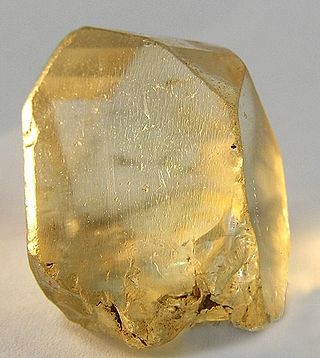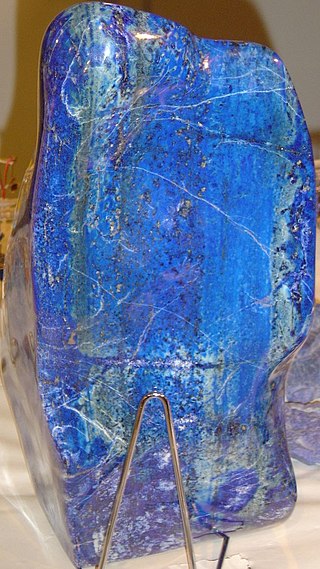Related Research Articles
Vedanta Limited is an Indian multinational mining company headquartered in Mumbai, with its main operations in iron ore, gold and aluminium mines in Goa, Karnataka, Rajasthan and Odisha.
Anglo American plc is a British multinational mining company with headquarters in London, England. It is the world's largest producer of platinum, with around 40% of world output, as well as being a major producer of diamonds, copper, nickel, iron ore, polyhalite and steelmaking coal. The company has operations in Africa, Asia, Australia, Europe, North America and South America.

Vale, formerly Companhia Vale do Rio Doce, is a Brazilian multinational corporation engaged in metals and mining and one of the largest logistics operators in Brazil. Vale is the largest producer of iron ore and nickel in the world. It also produces manganese, ferroalloys, copper, bauxite, potash, kaolin, and cobalt, currently operating nine hydroelectricity plants, and a large network of railroads, ships, and ports used to transport its products.

Severstal is a Russian company mainly operating in the steel and mining industry, headquartered in Cherepovets. Severstal is listed on the Moscow Exchange and LSE and is the largest steel company in Russia. The company is majority-owned and controlled by billionaire Alexey Mordashov.
Vedanta Resources Limited is a diversified mining company headquartered in London, United Kingdom. It is the largest mining and non-ferrous metals company in India and has mining operations in Australia and Zambia and oil and gas operations in three countries. Its main products are Zinc, Lead, Silver, Oil & Gas, Iron Ore, Steel, Aluminium and Power. It has also developed commercial power stations in India in Odisha and Punjab.

Cleveland-Cliffs Inc. is an American steel manufacturer based in Cleveland, Ohio. They specialize in the mining, beneficiation, and pelletizing of iron ore, as well as steelmaking, including stamping and tooling. The company was the world's 25th-largest steel producer and the third-largest in the United States in 2022. It is the largest flat-rolled steel producer in North America.

The mining of minerals in Nigeria accounts for only 0.3% of its gross domestic product, due to the influence of its vast oil resources. The domestic mining industry is underdeveloped, leading to Nigeria having to import minerals that it could produce domestically, such as salt or iron ore. The rights to ownership of mineral resources is held by the Federal Government of Nigeria, which grants titles to organizations to explore, mine, and sell mineral resources. Organized mining began in 1903, when the Mineral Survey of the Northern Protectorates was created by the British colonial government. A year later, the Mineral Survey of the Southern Protectorates was founded. By the 1940s, Nigeria was a major producer of tin, columbite, and coal. The discovery of oil in 1956 hurt the mineral extraction industries, as government and industry both began to focus on this new resource. The Nigerian Civil War in the late 1960s led many expatriate mining experts to leave the country. Mining regulation is handled by the Ministry of Solid Minerals Development, who are tasked with the responsibility of overseeing the management of all mineral resources in Nigeria. Mining law is codified in the Federal Minerals and Mining Act of 1999. Historically, Nigeria's mining industry was monopolized by state-owned public corporations. This led to a decline in productivity in almost all mineral industries. The Obasanjo administration began a process of selling off government-owned corporations to private investors in 1999. The Nigerian Mining Industry has picked up since the "Economic Diversification Agenda", from Oil & Gas, to Agriculture, Mining, etc., began in the country.

Mining in Afghanistan was controlled by the Ministry of Mines and Petroleum, prior to the August 15th takeover by the Taliban. It is headquartered in Kabul with regional offices in other parts of the country. Afghanistan has over 1,400 mineral fields, containing barite, chromite, coal, copper, gold, iron ore, lead, natural gas, petroleum, precious and semi-precious stones, salt, sulfur, lithium, talc, and zinc, among many other minerals. Gemstones include high-quality emeralds, lapis lazuli, red garnet and ruby. According to a joint study by The Pentagon and the United States Geological Survey, Afghanistan has an estimated US$1 trillion of untapped minerals.

The mineral industry is one of the main sectors of the Armenian economy and in 2017 accounted for 30.1% of its exports.
The mineral industry of Russia is one of the world's leading mineral industries and accounts for a large percentage of the Commonwealth of Independent States' production of a range of mineral products, including metals, industrial minerals, and mineral fuels. In 2005, Russia ranked among the leading world producers or was a significant producer of a vast range of mineral commodities, including aluminum, arsenic, cement, copper, magnesium compounds and metals, nitrogen, palladium, silicon, nickel and vanadium.
Resources are classified as either biotic or abiotic on the basis of their origin. India contains a multitude of both types of resource and its economy, especially in rural areas, is heavily dependent on their consumption or export. Due to overconsumption, they are rapidly being depleted.

Mining in the United Kingdom produces a wide variety of fossil fuels, metals, and industrial minerals due to its complex geology. In 2013, there were over 2,000 active mines, quarries, and offshore drilling sites on the continental land mass of the United Kingdom producing £34bn of minerals and employing 36,000 people.
Franco-Nevada Corporation is a Toronto, Ontario, Canada-based, gold-focused royalty and streaming company with a diversified portfolio of cash-flow producing assets. It is traded on the Toronto Stock Exchange and New York Stock Exchange.
Turquoise Hill Resources was a Canadian mineral exploration and development company headquartered in Montreal, Quebec, and a majority-owned subsidiary of Rio Tinto Group. The company was called Ivanhoe Mines until August 2, 2012 when a financing agreement was completed with Rio Tinto. Rio Tinto acquired full ownership of Turquoise Hill in December 2022.
Copper mining in the Democratic Republic of the Congo mainly takes place in the Copper Belt of the southern Katanga Province of the Democratic Republic of the Congo.
Kalukundi Mine is a copper and cobalt mine being developed in Katanga Province, Democratic Republic of the Congo (DRC) by Africo Resources, a Canadian company. In September 2008 the company estimated the value of the resource as $1.47 billion.

Oil and gas dominate the extraction industries of the Republic of the Congo, also referred to as Congo-Brazzaville. The petroleum industry accounted for 89% of the country’s exports in 2010. Among African crude oil producers in 2010, The Congo ranked seventh. Nearly all of the country's hydrocarbons were produced off-shore. The minerals sector is administered by the Department of Mines and Geology. Presently no major mining activities are underway, although there are some small-scale domestic operations. However, the country does have numerous large-scale undeveloped resources. The country has recently attracted a strong influx of international companies seeking to tap into the vast mineral wealth.
The Hrazdan mine is a large mine in the center of Armenia in Kotayk Province. Hrazdan represents one of the largest iron reserve in Armenia having estimated reserves of 77 million tonnes of ore grading 40% iron.
The Abovyan mine is a large mine in the center of Armenia in Kotayk Province. Abovyan represents one of the largest iron reserve in Armenia having estimated reserves of 255 million tonnes of ore grading 40% iron.

The Ministry of Energy Infrastructures and Natural Resources of Armenia is the ministry responsible for the management of the energy systems, and control of the exploitation of natural resources in Armenia. It elaborates and implements the policies of the Government of Armenia in the energy sector.
References
- ↑ "Fortune oil acquire stake in Armenian iron ore mines" (PDF). fortune-oil.com. 2010. Archived from the original (PDF) on 2016-03-04. Retrieved 2013-06-29.
- 1 2 "Fortune Oil to invest $500 mln in Armenia's mining". Reuters. 2011-02-23. Retrieved 2022-10-03.
- ↑ Ecolur. "Dark Games around Svarants Mine - Ecolur". www.ecolur.org. Retrieved 2022-10-03.